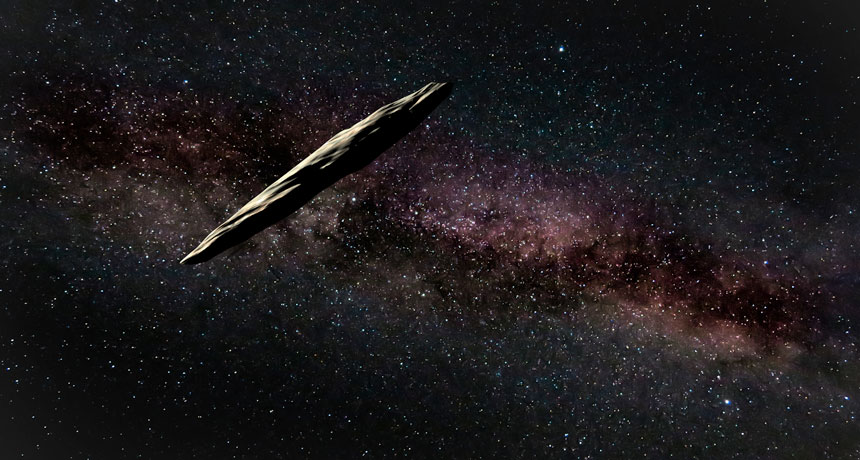Our first interstellar visitor may be a camouflaged comet
An itinerant interstellar asteroid may actually be a comet in disguise.
Known as ‘Oumuamua, the object was detected in October and is the first visitor from another star spotted touring our solar system (SN: 11/ 25/17, p. 14). Early observations suggested the vagabond was rocky. But after additional analysis, a team of researchers suggests December 18 in Nature Astronomy that the object might have an icy core.
In general, comets are icy and asteroids are rocky. Ice gives comets their characteristic tails: As a comet passes near the sun, the heat warms the ice, causing it to sublimate, releasing gas and dust. Because no tail appeared despite ‘Oumuamua’s passage by the sun, the mysterious visitor was dubbed an asteroid — a surprising conclusion since the vast majority of objects ejected from star systems are expected to be icy.
“Everybody's been assuming that this is just a lump of rock,” says astronomer Alan Fitzsimmons of Queen’s University Belfast in Northern Ireland. “This may not be the case.” So ‘Oumuamua might not be as odd as originally thought.
Fitzsimmons and colleagues used the Very Large Telescope in Chile and the William Herschel Telescope in La Palma, Spain to capture the object’s spectrum — its light sliced up according to wavelength. “It’s an impressive piece of work,” says astronomer Olivier Hainaut of the European Southern Observatory in Garching, Germany, who was not involved with the research. “It was a very faint object and to observe such a faint moving target is horribly difficult.”
The object’s spectrum revealed a reddish hue with no signs of ice. But ‘Oumuamua could have an exterior crust — about half a meter thick or thicker — which hid the ice and insulated it from the sun’s heat, the researchers calculated. “You could have a lot of ice in this thing and really not know it,” says astronomer Jessica Sunshine of the University of Maryland in College Park, who was not involved with the research. Such a crust could have formed as energetic particles known as cosmic rays bombarded the object over its lifetime, creating an ice-free surface rich in organic compounds. ‘Oumuamua’s spectrum is similar to those of other objects in the solar system suspected of concealing such icy interiors.
Studies of ‘Oumuamua continue — with some researchers looking for evidence of even more surprising hypotheses. Using the Green Bank Telescope in West Virginia, scientists with the Breakthrough Listen project are searching for signatures of artificial origin — that is, aliens — on the off chance that the object might be an interstellar spacecraft.